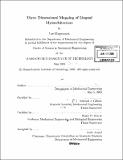Three dimensional mapping of lingual myoarchitecture
Author(s)
Magnusson, Lee (Lee H.)
DownloadFull printable version (8.509Mb)
Alternative title
3D mapping of lingual myoarchitecture
Other Contributors
Massachusetts Institute of Technology. Dept. of Mechanical Engineering.
Advisor
Richard J. Gilbert and Roger Kamm.
Terms of use
Metadata
Show full item recordAbstract
The tongue is a structurally complex muscular organ, composed of a continuum of variably aligned intrinsic and extrinsic fibers. An understanding tongue structure and function, both under normal and pathological conditions, requires a complete three dimensional representation of fiber orientations present in the whole tissue. In order to investigate lingual myoarchitecture in the mammalian tongue, we employed several magnetic resonance imaging techniques generally based on direction specific differences in water diffusion. Muscle tissue in particular exhibits significant diffusion anisotropy in the direction of fibers, from which diffusion imaging is able to infer fiber direction. In this thesis research, several diffusion weighted MRI signal acquisition and post processing methods were tested, namely diffusion spectrum imaging (DSI), DSI with tractography, q-ball imaging, diffusion tensor imaging (DTI), and ADC and FA mapping. Each imaging method was evaluated in three ways: 1) finite element simulation using 2D structures to model the diffusion environment in an idealized situation, 2) MRI of microfluidic phantoms to quantify the effects of experimental conditions with a known diffusion environment, and 3) MRI of biological tissue, namely ex vivo cow and in vivo human tongues. The results demonstrated the capacity of DSI alone and in association with tractography to depict complex intravoxel and intervoxel fiber populations, in which a voxel is a 1-5 mm cubic imaged volume. In particular, our findings have identified and characterized on a structural basis a novel set of interwoven fiber populations. (cont.) Future work will be directed to defining the mechanical significance of these interwoven fiber populations in carrying physiological tissue deformations.
Description
Thesis (S.M.)--Massachusetts Institute of Technology, Dept. of Mechanical Engineering, 2005. Includes bibliographical references (p. 77-82).
Date issued
2005Department
Massachusetts Institute of Technology. Department of Mechanical EngineeringPublisher
Massachusetts Institute of Technology
Keywords
Mechanical Engineering.